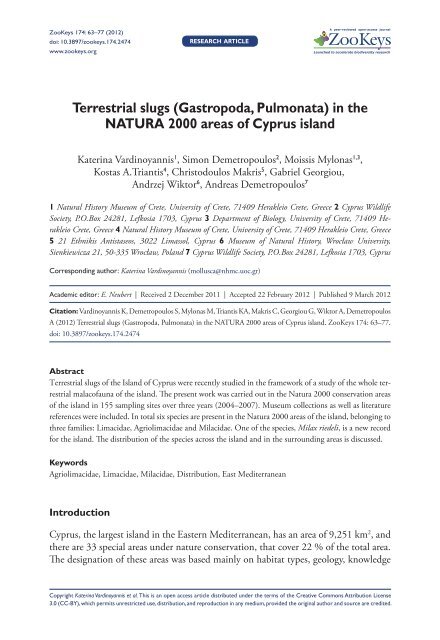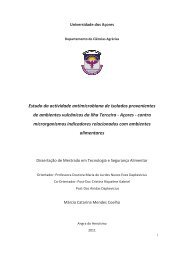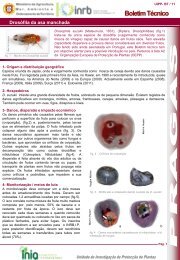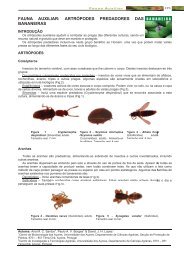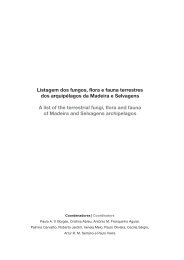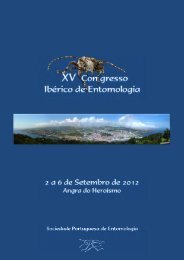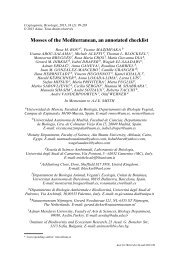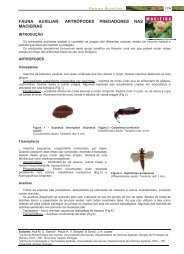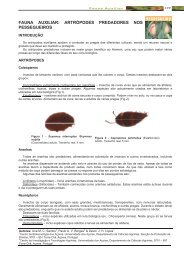(Gastropoda, Pulmonata) in the NATURA 2000 areas of Cyprus island
(Gastropoda, Pulmonata) in the NATURA 2000 areas of Cyprus island
(Gastropoda, Pulmonata) in the NATURA 2000 areas of Cyprus island
- No tags were found...
You also want an ePaper? Increase the reach of your titles
YUMPU automatically turns print PDFs into web optimized ePapers that Google loves.
Slugs <strong>of</strong> <strong>Cyprus</strong> 65<strong>NATURA</strong> <strong>2000</strong> area Sampl<strong>in</strong>g site with slugs DateNumberDom<strong>in</strong>ant Vegetationon mapSubstrateAlyki, Tekes (site 1) 15/1/2005 95Alykes Larnakas Larnaka salt marsh newPlantations with Acacia Sand, silts19/11/2005 96build<strong>in</strong>gsPillow lavas,Oliv<strong>in</strong>eAlykos Potamos–AgiosSozomenosKotsiatis Dam (CY202–1) 4/3/2006 81 Phrygana (S. sp<strong>in</strong>osum)- PyroxeneCha PotamiChersonisos AkamaDasos Lemesou–Periochi KyparisiaDasos MachairaDasos PafouCha river, Kato Archimantria5/3/2005 52 Maquis (O. europaea & Chalks,C. siliqua)marlsCha river, Orites 5/3/2005 51Agios Kononas spr<strong>in</strong>gs 24/11/2005 1Agios M<strong>in</strong>as spr<strong>in</strong>gCY410–1115/3/2005 4Akamas (may be Loutra tisAfroditis)1/10/1989 3Akamas forest CY 410–8 12/3/2005 6 Maquis (JuniperusAkamas, Loutra tis AfroditisCY 410–10phoenicea, O. europaea,15/3/2005 2 C. siliqua);LimestonePhrygana (S. sp<strong>in</strong>osum);Avakas 19/2/2005 8P<strong>in</strong>e forests (P. brutia)Mountiko maquis24/1/2005 9CY410–3Petratis gorge 23/11/2005 7Pittokopos CY410–13 16/3/2005 5Pykni forest CY410–4 15/2/2005 10Germasogeia north, at <strong>the</strong>20/2/<strong>2000</strong> 59stream (CY 20)Serpent<strong>in</strong>izedLemesos forest, AkrountaP<strong>in</strong>e forest (P. brutia);11/2/2006 62harzburgites,Diabaseriver valleyMaquis (O. europaea,Lemesos forest, Fo<strong>in</strong>ikaria 2/1/2005 61 C. siliqua)dykes andLemesos forest, Germasogeiadam, Fo<strong>in</strong>ikaria2/1/2005 60gabbrosGionia Camp (CY204–2) 17/3/2006 87Gionia Valley north(CY204–3)17/3/2006 85Kapedes (CY204–1) 17/3/2006 82DiabaseForest (Q. alnifolia, P.Kiona ~1380m alt 22/12/2006 86dykes andbrutia)Lazania CY 204–7 27/12/2006 84pillow lavasMachairas, Kyprovasa– Arkatzitou Klosmatou22/12/2006 88Philani P<strong>in</strong>e CY 204–6 27/12/2006 83Dasos Pafou Tripyla 7/1/2006 29Gerakies (CY 206–3) 15/3/2006 32Kedron valley 13/3/2005 28Kedron valley (CY 10) 18/2/<strong>2000</strong> 27Kremnos tis Pellis CY206–115/3/2006 30Roudia Bridge (site CY7) 17/2/<strong>2000</strong> 33Syllad<strong>in</strong> tou Petrou nearTsakistra15/3/2006 31Forests with P<strong>in</strong>es (P.brutia) and Cedars(Cedrus brevifolia)Diabasedykes
66Kater<strong>in</strong>a Vard<strong>in</strong>oyannis et al. / ZooKeys 174: 63–77 (2012)<strong>NATURA</strong> <strong>2000</strong> area Sampl<strong>in</strong>g site with slugs DateNumberDom<strong>in</strong>ant Vegetationon mapSubstrateDasos StavrovouniouStavrovouni, entrance <strong>of</strong>19/12/2006 93monasteryP<strong>in</strong>e forest (P. brutia); DiabaseMaquis (O. europaea, dykes andStavrovouni, low 19/12/2006 92C. siliqua)pillow lavasStavrovouni, NE low 19/12/2006 94Drymou Oak 28/3/2007 16Biocalcarenites,DrymouRiparianDrymou Valley 28/3/2007 15sandstonesEzousas Alder (CY405–1) 11/2/2006 22Episkopi tou MorouSand, silts,Ezousas PseudogarrigueMaquis (Q. coccifera)Nerou11/2/2006 21clays(CY405–2)Caledonian falls 22/11/2005 63Gabbros,Ethniko Dasiko Mesapotamos waterfall 22/11/2005 65 P<strong>in</strong>e forests (P.nigra, P.harzburgitesParko Troodous Platres to Mesapotamos 22/11/2005 64 brutia)Troodos mt., Almyrolivado 26/11/2005 66Cavo Gkreko Rocks 9/1/2005 99Kavo GkrekoGkreco cape at Agioi Anargyroi(CY 24)Phrygana (S. sp<strong>in</strong>osum)Maquis (J. phoenicea);21/2/<strong>2000</strong> 98LimestoneParalimniou lake 9/1/2005 97Diarizos Arm<strong>in</strong>ou 28/1/2006 49Diarizos gorge, after KikisiaKoilada DiarizouKoilada LimnatiKritou MarotouLefkaronMadari–Papoutsa17/2/<strong>2000</strong> 47(CY 8)Diarizos Kidasi 22/1/2006 45Diarizos Nikokleia 28/1/2006 44Diarizos valley, Gefyri 22/1/2005 48Diarizos valley, Petres ton22/1/2005 46HasanpoulionLimnatis valley, 1 km west<strong>of</strong> <strong>the</strong> bridge, 400 m alt.5/12/2004 58Limnatis valley, Alassa 19/11/2005 55Limnatis valley, Mantra 18/2/2006 54Palia Korfi, approx. 500 mMaquis (O. europaea, C.siliqua);Phrygana (S. sp<strong>in</strong>osum);P<strong>in</strong>e forests (P. brutia)Maquis (O. europaea, C.siliqua)alt., Limnatis valley4/12/2004 56Palia Korfi, river below atLimnatis bridge4/12/2004 57Kritou Marotou Cultivations27/3/2007 24 Riparian and cultivationsKritou Marotou Oak 27/3/2007 23Lefkara–Agios M<strong>in</strong>as 25/2/2006 91Presteppe scrub (GenistaLefkara 600 m alt 19/11/2005 89fasselata; Maquis (Q.Lefkara croosroad to Kato11/3/2006 90 coccifera)DrysKyperounda (CY205–1) 25/3/2006 67Lagoudera valley 20/12/2006 70Lagoudera, 6 km north 21/12/2006 73Papoutsa ~1240m alt. 20/12/2006 72 Forest (Q. alnifolia, P.Pitsilia district, Kyperounta 15/4/2001 68 brutia)Polystypos Fountoukies 17/12/2006 71Spilia–Madari, 1250m alt. 17/12/2006 69Xyliati dam, low 21/12/2006 74Chalks,sand, lavabrecciaChalks, serpent<strong>in</strong>iteChalks,marls, claysChalks,marls andpillow lavasDiabasedykes andpillow lavas
Slugs <strong>of</strong> <strong>Cyprus</strong> 67<strong>NATURA</strong> <strong>2000</strong> area Sampl<strong>in</strong>g site with slugsDateNumberon mapDom<strong>in</strong>ant Vegetation SubstrateMammari–Deneia Mammari 1st site 21/11/2005 80 Phrygana (S. sp<strong>in</strong>osum)MaroullenaMavrokolymposPeriochi MitserouMaroulena gorge 17/12/2006 75Maroulena’s Dam 23/12/2006 76Maroulena’s P<strong>in</strong>e 23/12/2006 77Agios Neophytos ValleyCY408–413/1/2006 20Agios Neophytos GarrigueCY408–313/1/2006 19Mavrokolymbos GarrigueCY408–19/1/2006 18Mavrokolymbos StreamCY408–29/1/2006 17Mitsero–Agios Panteleimonas11/3/2006 79Mitsero P<strong>in</strong>ewood & valley 11/3/2006 78P<strong>in</strong>e forest (P. brutia)and RiparianMaquis (O. europaea,C. siliqua); Phrygana (S.sp<strong>in</strong>osum)Phrygana (S. sp<strong>in</strong>osum);P<strong>in</strong>e forest (P. brutia)Biocalcarenites,sandstonesPillow lavasChalks,marlsChalk &LimestonePlatyPlaty area, crossroad Kelefos–Kam<strong>in</strong>aria–MilikouridykesDiabase19/2/2005 50 P<strong>in</strong>e forest (P. brutia)Polis Gialia Gialia Acacia CY401–1 8/1/2006 14 Plantations with AcaciaCalcarenites,sands,gravelSkoulliChrysochou River15/1/2006 12 Woodland (Q.<strong>in</strong>fectoria);CY409–2Sand, silts,Riparian (Platanus orientalis,Neriumgraveloleander)Goudi Oak CY409–1 15/1/2006 11Polis Camp river CY409–3 15/1/2006 13Vouni Panagias Agia Moni south <strong>of</strong> Panagia 22/12/2004 34Makries Limnes Chasanpoulion–Eryfiou–Pr<strong>of</strong>itis23/12/2004 36IliasPr<strong>of</strong>itis Ilias 1/2/2005 35Vloudkia 23/12/2004 37Asprokremnos PoolsCY407–12/2/2006 43F<strong>in</strong>ikas CY407–2 2/2/2006 42Xeros Potamos Nata P<strong>in</strong>e CY407–5 6/2/2006 39Xeros Army CY407–3 2/2/2006 41Xeros Rock CY407–4a 3/2/2006 38Xirou valley, Nata 5/2/2005 40Stavros tis PsokasAgios MerkouriosStavros tis Psokas (CY 11) 18/2/<strong>2000</strong>Ethniko DasikoParko RizoeliasAsgataNo slugs were foundLympion–Agia Anna <strong>in</strong> <strong>the</strong>se <strong>areas</strong>PeristeronaKoilada KargotisForests (Q. <strong>in</strong>fectoria,P<strong>in</strong>us brutia)Phrygana (S. sp<strong>in</strong>osum);Maquis (O. europaea, C.siliqua);P<strong>in</strong>e forests (P. brutia)P<strong>in</strong>e forestsChalks,marlsChalks,marlsDiabasedykesIn Table 1 we give <strong>the</strong> sampl<strong>in</strong>g sites <strong>in</strong> each <strong>NATURA</strong> <strong>2000</strong> area, <strong>the</strong> date <strong>of</strong> collection,<strong>the</strong> vegetation type, <strong>the</strong> dom<strong>in</strong>ant plant and <strong>the</strong> substrate.Initially we assembled all data from <strong>the</strong> literature, <strong>in</strong>clud<strong>in</strong>g <strong>the</strong> doubtful names.These are presented and discussed separately for each species.
68Kater<strong>in</strong>a Vard<strong>in</strong>oyannis et al. / ZooKeys 174: 63–77 (2012)Map 1. Natura <strong>2000</strong> <strong>areas</strong> A and sampl<strong>in</strong>g sites B <strong>in</strong> each area. Numbers depict sampl<strong>in</strong>g sites whereslugs were found (<strong>the</strong>ir name is given <strong>in</strong> Table 1)ResultsIn total we found six slug species belong<strong>in</strong>g to three families - Agriolimacidae, Limacidaeand Milacidae. Below we present analytically for each species <strong>the</strong> collect<strong>in</strong>g sites <strong>in</strong>each <strong>NATURA</strong> <strong>2000</strong> conservation area (bold), data from literature, and if necessarycomments on its systematics.Family Agriolimacidae Wagner, 1935Deroceras berytensis (Bourguignat, 1852)This species had been reported from Akrotirio Aspro–Petra tou Romiou; Alykes Larnakas;Chersonisos Akama; Ethniko Dasiko Parko Troodous; Koilada Diarizou; PolisGialia and Vouni Panagias (Rähle 1984, 1991).We found it <strong>in</strong> (Fig. 1a): Alykes Larnakas: Larnaka salt marsh new buld<strong>in</strong>gs,19.11.05, M; Alyki Tekes, 15.1.05, MG. Alykos Potamos – Agios Sozomenos:Kotsiatis Dam (CY202–1), 4.3.2006, SD. Cha Potami: Cha river, Kato Archimandria,5.03.05, MG. Chersonisos Akama: Agios M<strong>in</strong>as spr<strong>in</strong>g CY 410–11, 15.3.05,AD; Agios Kononas spr<strong>in</strong>gs, 24/11/2005, AD; Akamas (may be Loutra tis Afroditis),1.10.1989, MM; Petratis gorge, 23.11.05, MM; Pittokopos CY 410–13, 16.03.05,
Slugs <strong>of</strong> <strong>Cyprus</strong> 71are justified and agree with our own observations; accord<strong>in</strong>g to Wiktor (<strong>2000</strong>), at <strong>the</strong>current state <strong>of</strong> knowledge it is reasonable to regard <strong>the</strong> name A. cyprium as a juniorsynonym <strong>of</strong> <strong>the</strong> widely distributed and very variable D. berytensis, ra<strong>the</strong>r than use nameswithout know<strong>in</strong>g what <strong>the</strong>y refer to. It cannot be excluded that Simroth (1906) wasdeal<strong>in</strong>g not only with D. berytensis but also for example with D. famagustensis.Deroceras chrysorroyatissensis Rähle, 1984This species had been reported from Akrotirio Aspro–Petra tou Romiou and VouniPanagias (Rähle 1991).We found it <strong>in</strong> (Fig. 1b): Agiatis: Agiatis–Agia S (CY411–1), 14.03.06, MM,V, AD, SD; Agiatis – 500m from Tarmac CY411–2, 14.03.06, MM, V, AD, SD.Akrotirio Aspro – Petra tou Romiou: Aspro cape – Petra tou Romiou (eastern valley),29.01.05, M. Cha Potami: Cha river Orites, 5.03.05, MG. Chersonisos Akama:Pykni forest CY 410–4, 15.02.05, SD ? juv.; Akamas (may be Loutra tis Afroditis),1.10.89, MM; Akamas, Loutra tis Afroditis CY410–10, 15.03.05, SD; Avakas,19.02.05, SD; Mountiko maquis CY410–3, 24.01.05, SD ? juv.; Petratis gorge,23.11.05, MM; Akamas forest CY 410–8, 12.03.05, SD. Dasos Lemesou – PeriochiKyparisia: Lemesos forest, Akrounta river valley, 2.01.06, MG. Dasos Pafou: GerakiesCY206–3, 15.03.06, MM, V, AD, SD; Kremnos tis Pellis CY 206–1, 15.3.06.MM, V, AD, SD; Syllad<strong>in</strong> tou Petrou CY206–2, 15.03.06, MM, V, AD, SD; Kedronvalley, 13.03.05, MG; Dasos Pafou–Tripyla, 7.01.06, AD; Kedron valley (CY 10),18.02.00, V. Dasos Stavrovouniou: Stavrovouni, entrance <strong>of</strong> monastery, 19.12.06,MM, V; Stavrovouni, NE low, 19.12.06, MM, V; Stavrovouni, low, 19.12.06, MM,V. Episkopi tou Morou Nerou: Ezousas Pseudogarrigue (CY 405–2), 11.02.06, SD.Ethniko Dasiko Parko Troodous: Mesapotamos waterfall, 22.11.05, V; Troodos mt.Almyrolivado, 26.11.05, M; Platres to Mesapotamos, 22.11.05, MM. Koilada Diarizou:Diarizos Arm<strong>in</strong>ou, 28.01.06, MG; Diarizou valley, Gefyri, 22.1.05, MG. KoiladaLimnati: Limnatis valley, Alassa, 19.11.05, MG; Palia Korfi, river below at Limnatisbridge, 5.12.04, MG; Palia Korfi, approx. 500m alt. Limnatis valley, 5.12.04,MM; Limnatis valley, Mantra, 18.02.06, M. Lefkaron: Lefkara 600m alt., 19.11.05,MM. ? juv.; Lefkara croosroad to Kato Drys, 11.03.06, MM. Madari – Papoutsa:Xyliati dam, low, 21.12.06. MM, V; Lagoudera 6 km north, 21.12.06, MM, V; Pitsiliadistrict, Kyperounta, 15.04.01 ? juv.; Kyperounta (CY 205–1), 25.03.06, SD;Spilia – Madari, 1250m alt., 17.12.06, MM, V. Mavrokolympos: Agios NeophytosGarrigue CY 408–3, 13.01.06, SD. Periochi Mitserou: Mitsero, P<strong>in</strong>ewood & valleyCY203–2, MM, V, AD, SD; Mitsero–Agios Panteleimonas, 11.03.06, MM, V, AD,SD. Platy: Platy area crossroad Kelefos–Kam<strong>in</strong>aria– Milikouri, 19.02.05, MG. Skoulli:Polis Camp river CY409–3, 15.01.06, SD; Goudi Oak CY409–1, 15.01.06, AD.Vouni Panagias: Makries Limnes Chasanpoulion – Eryfiou – Pr<strong>of</strong>itis Ilias, 23.12.04,V; Pr<strong>of</strong>itis Ilias, 1.02.05, MG; Vloudkia, 23.12.04, MG; Agia Moni south <strong>of</strong> Panagia,22.12.04, MG. Xeros Potamos: Nata P<strong>in</strong>e CY407–5, 6.02.06, SD.
72Kater<strong>in</strong>a Vard<strong>in</strong>oyannis et al. / ZooKeys 174: 63–77 (2012)Comments on systematic charactersThe slug is easy to recognise even based solely on its external appearance. As emphasisedby Rähle (1984), <strong>the</strong> species is characterised by very little variation <strong>of</strong> <strong>the</strong> characterswhich are regarded as diagnostic: <strong>the</strong> external colour pattern on <strong>the</strong> body, <strong>the</strong>penis shape, with its external and <strong>in</strong>ternal accessory structures, and <strong>the</strong> absence <strong>of</strong> arectal caecum. Only <strong>the</strong> appendix at <strong>the</strong> posterior end <strong>of</strong> <strong>the</strong> penis may vary <strong>in</strong> shape.This constancy <strong>of</strong> characters is exceptional with<strong>in</strong> <strong>the</strong> genus Deroceras. In all likelihoodit is endemic to <strong>Cyprus</strong>. O<strong>the</strong>rwise, a slug with such a characteristic appearance wouldhave been noticed elsewhere.Deroceras famagustensis Rähle, 1991It had not been reported from any <strong>NATURA</strong> <strong>2000</strong> site.We found it <strong>in</strong> (Fig. 1c): Dasos Lemesou – Periochi Kyparisia: Lemesos forest,Fo<strong>in</strong>ikaria, 2.1.2005, MG. Dasos Machaira: Gionia Valley north (CY204–3),17.03.06, SD; Lazania CY 204–7, 27.12.06, SD; Kapedes (CY204–1), 17.03.06,MM; Kiona – 1380 m alt., 22.12.06, MM, V; Machairas Kyprovasa–Arkatzi touKlosmatou, 22.12.06, MM, V; Gionia Camp CY204–2, 17.03.06, SD; Philani P<strong>in</strong>eCY204–6, 27.12.06, SD. Kavo Gkreko: Paralimniou lake, 9.1.2005, MG. Madari –Papoutsa: Papoutsa 1240 m alt., 20.12.06, MM; Xyliati dam, low, 21.12.06, MM, V.Maroullena: Maroulena’s P<strong>in</strong>e, 23.12.06, D.Comments on systematic charactersWe found only unspotted specimens, which is <strong>in</strong> agreement with Rähle (1991), though<strong>the</strong> mantle <strong>of</strong>ten gives an impression <strong>of</strong> be<strong>in</strong>g speckled with a dark pigment. Thus <strong>the</strong>colour is not uniform. The back, outside <strong>the</strong> mantle, is covered by a pattern <strong>in</strong> <strong>the</strong>form <strong>of</strong> a dark reticulation follow<strong>in</strong>g <strong>the</strong> system <strong>of</strong> sk<strong>in</strong> grooves; <strong>the</strong> dark pigmentconcentrates <strong>in</strong> <strong>the</strong>se grooves. Most specimens have th<strong>in</strong> and s<strong>of</strong>t sk<strong>in</strong>. The penis isth<strong>in</strong>-walled, <strong>of</strong> vary<strong>in</strong>g shape. Inside it, complicated structures adher<strong>in</strong>g to <strong>the</strong> peniswall form a k<strong>in</strong>d <strong>of</strong> pocket. When everted, <strong>the</strong>y form a nearly circular shallow bowlor a slightly concave shield. Rähle (1991) mentions <strong>the</strong> absence <strong>of</strong> a stimulator, butapparently this structure should be regarded as one <strong>of</strong> an unusual shape. Its positionwith<strong>in</strong> <strong>the</strong> penis, as well as when everted, clearly <strong>in</strong>dicates that this is its role. The caecumis vestigial. This species is endemic to <strong>Cyprus</strong>.There are three Natura <strong>2000</strong> <strong>areas</strong>, namely Drymou, Stavros tis Psokas and KritouMarotou, where we found only juvenile Deroceras.
74Kater<strong>in</strong>a Vard<strong>in</strong>oyannis et al. / ZooKeys 174: 63–77 (2012)Figure 2. Distribution <strong>of</strong> a L. flavus b M. barypus and c M. riedeli <strong>in</strong> <strong>the</strong> Natura <strong>2000</strong> <strong>areas</strong> <strong>of</strong> conservation<strong>in</strong> <strong>Cyprus</strong> Island.
Slugs <strong>of</strong> <strong>Cyprus</strong> 75three species known from <strong>the</strong> Natura <strong>2000</strong> <strong>areas</strong>; thus we have doubled <strong>the</strong> number<strong>of</strong> species. Tandonia sowerbyi is <strong>the</strong> only species that has been recorded from <strong>the</strong> <strong>island</strong>(Rähle 1991; pers. obs.) but still not <strong>in</strong> <strong>the</strong> <strong>NATURA</strong> <strong>2000</strong> <strong>areas</strong>. However, we cannotexclude <strong>the</strong> possibility <strong>of</strong> f<strong>in</strong>d<strong>in</strong>g this species <strong>in</strong> one <strong>of</strong> <strong>the</strong> <strong>areas</strong> <strong>in</strong> <strong>the</strong> future, s<strong>in</strong>ce <strong>in</strong><strong>the</strong> Mediterranean it can be found <strong>in</strong> undisturbed as well as disturbed places (Wiktor2001). The slug fauna <strong>in</strong> <strong>the</strong> <strong>NATURA</strong> <strong>2000</strong> <strong>areas</strong> <strong>of</strong> conservation <strong>of</strong> <strong>Cyprus</strong> appearsat first glance equally rich as <strong>the</strong> correspond<strong>in</strong>g <strong>areas</strong> <strong>of</strong> <strong>the</strong> <strong>island</strong> <strong>of</strong> Crete (seven specieson Crete, Vard<strong>in</strong>oyannis 1994, Wiktor et al. 1994). However, on Crete <strong>the</strong>re are10 slug species on <strong>the</strong> whole <strong>island</strong>, and thus only 70% <strong>of</strong> <strong>the</strong> slug fauna is found <strong>in</strong><strong>the</strong> conservation <strong>areas</strong>, compared to 85.7% on <strong>Cyprus</strong>. It seems that <strong>the</strong> slug fauna <strong>of</strong><strong>Cyprus</strong> is well represented <strong>in</strong> <strong>the</strong> <strong>NATURA</strong> <strong>2000</strong> <strong>areas</strong>, regardless on which basis <strong>the</strong>se<strong>areas</strong> were proposed.D. chrysorroyatissensis and D. berytensis are <strong>the</strong> most widespread species, both present<strong>in</strong> 19 <strong>areas</strong>; but <strong>the</strong> latter is distributed all around <strong>the</strong> <strong>island</strong>, while D. chrysorryatissensishas a more restricted distribution. All <strong>the</strong> o<strong>the</strong>r species are found <strong>in</strong> 2–5 <strong>areas</strong><strong>of</strong> conservation.Three species are endemic to <strong>the</strong> <strong>island</strong>, namely D. chrysorryatissensis, D. famagustensisand M. barypus. One species, M. riedeli, is distributed on <strong>Cyprus</strong> and <strong>the</strong>sou<strong>the</strong>ast coast <strong>of</strong> Turkey (Schütt 2005), while L. flavus is found all around <strong>the</strong> Mediterraneanand Europe (Wiktor 2001) and D.berytensis all around <strong>the</strong> eastern Mediterranean(Heller 2009; Wiktor <strong>2000</strong>; Schütt 2005).There are five <strong>NATURA</strong> <strong>2000</strong> <strong>areas</strong> where no slugs were found – Ethniko DasikoParko Rizoelias, Asgata, Lympion – Agia Anna, Peristerona and Koilada Kargotis. In<strong>the</strong> first two <strong>areas</strong> <strong>the</strong> substrate is ma<strong>in</strong>ly gypsum which is most probably <strong>the</strong> reasonfor <strong>the</strong>ir absence. In <strong>the</strong> o<strong>the</strong>r <strong>areas</strong> <strong>the</strong> substrate is limestone, and <strong>the</strong> vegetation isMediterranean scrubland (maquis and phrygana). Based on all <strong>the</strong> characteristics <strong>of</strong><strong>the</strong>se <strong>areas</strong> <strong>the</strong>re is no obvious explanation for <strong>the</strong> absence <strong>of</strong> slugs, and we consider itas possible that slugs might be found <strong>in</strong> <strong>the</strong> future.The richest Natura <strong>2000</strong> area is Madari – Papoutsa, <strong>in</strong> <strong>the</strong> center <strong>of</strong> <strong>the</strong> <strong>island</strong>,with five <strong>of</strong> <strong>the</strong> six species present (Fig. 3). This is followed by Dasos Lemesou – PeriochiKyparisia. There is only one site, Xyliati dam, where all three Deroceras species cooccur;additionally, at this site L. flavus was also found. In most o<strong>the</strong>r localities <strong>the</strong>re isonly one slug species present, usually D. berytensis. Milacidae are very restricted: eachspecies has been found <strong>in</strong> only two <strong>of</strong> <strong>the</strong> <strong>NATURA</strong> <strong>2000</strong> <strong>areas</strong>.D. chrysorroyatissensis was known from very few localities <strong>in</strong> <strong>the</strong> southwest part <strong>of</strong><strong>the</strong> <strong>island</strong> (Rähle 1991; Wiktor 2001) but with our study it appears that this specieshas a wider distribution, it is absent from <strong>the</strong> nor<strong>the</strong>rn and <strong>the</strong> easternmost part <strong>of</strong><strong>Cyprus</strong>.D. famagustensis had been reported only from Cavo Gkreco, <strong>the</strong> sou<strong>the</strong>astern pen<strong>in</strong>sula<strong>of</strong> <strong>the</strong> <strong>island</strong>, but we found it <strong>in</strong> <strong>the</strong> central part <strong>of</strong> <strong>Cyprus</strong>. Fur<strong>the</strong>r studies couldenlarge its known distribution still fur<strong>the</strong>r.Until recently, L. flavus had been known only from sites near human settlements,but we found it also <strong>in</strong> more natural <strong>areas</strong>.
76Kater<strong>in</strong>a Vard<strong>in</strong>oyannis et al. / ZooKeys 174: 63–77 (2012)AgiatisAkrotirio Aspro - Petra tou RomiouAlykes LarnakasAlykos Potamos - Agios SozomenosAsgataCha PotamiChersonisos AkamaDasos Lemesou - Periochi KyparisiaDasos MachairaDasos PafouDasos StavrovouniouDrymouEpiskopi tou Morou NerouEthniko Dasiko Parko RizoeliasEthniko Dasiko Parko TroodousKargotisKavo GkrekoKoilada DiarizouKoilada LimnatiKritou MarotouLefkaronLympion - Agia AnnaMadari - PapoutsaMammari - DeneiaMaroullenaMavrokolymposPeriochi MitserouPeristeronaPlatyPolis GialiaSkoulliStavros tis PsokasVouni PanagiasXeros PotamosNumber <strong>of</strong> Species0 1 2 3 4 5 6Figure 3. Number <strong>of</strong> slug species <strong>in</strong> each Natura <strong>2000</strong> area. Bars <strong>in</strong> black depict juvenile <strong>in</strong>dividuals.M. barypus was known from three suburban <strong>areas</strong> <strong>in</strong> <strong>the</strong> eastern and nor<strong>the</strong>rn part<strong>of</strong> <strong>the</strong> <strong>island</strong> but we also found it <strong>in</strong> central <strong>Cyprus</strong>.M. riedeli is recorded for <strong>the</strong> first time from <strong>the</strong> <strong>island</strong>. It is distributed <strong>in</strong> <strong>the</strong> centralpart <strong>of</strong> <strong>the</strong> <strong>island</strong> <strong>in</strong> <strong>the</strong> area <strong>of</strong> Madari–Papoutsa.The presence <strong>of</strong> <strong>the</strong> slug species does not seem to correlate with vegetation, ra<strong>in</strong>fall,altitude or <strong>the</strong> substrate <strong>of</strong> <strong>the</strong> site <strong>the</strong>y were found.All slugs were active only dur<strong>in</strong>g <strong>the</strong> wet period; L. flavus <strong>in</strong> <strong>the</strong> urban <strong>areas</strong> is anexception, as it was found active also dur<strong>in</strong>g <strong>the</strong> dry season, even <strong>in</strong> summer (pers. obs.).
Slugs <strong>of</strong> <strong>Cyprus</strong> 77In <strong>the</strong> future we will present more data on this group s<strong>in</strong>ce we are currently study<strong>in</strong>g<strong>the</strong> terrestrial malac<strong>of</strong>auna <strong>of</strong> <strong>the</strong> whole <strong>island</strong>.AcknowledgmentsWe wish to thank Maria Tzatzi for her valuable help <strong>in</strong> <strong>the</strong> laboratory work, ManolisNikolakakis for his help with <strong>the</strong> GIS presentation, and Heike Reise for review<strong>in</strong>g <strong>the</strong>manuscript.This work was part <strong>of</strong> <strong>the</strong> research project “The study <strong>of</strong> land snails <strong>in</strong> <strong>the</strong> NATU-RA <strong>2000</strong> <strong>areas</strong>- SUSTDEV/0104/05” funded by <strong>the</strong> Research Promotion Foundation<strong>of</strong> <strong>Cyprus</strong>.ReferencesBourguignat MJR (1853) Catalogue raisonne des mollusques terrestres et fluviatiles recueillispar M.F. de Saulcy pendant son voyage en Orient. Gide & Baudry, Paris, 96 pp, 4 pl.Dimitrakopoulos PG, Memtsas D, Troumbis AY (2004) Question<strong>in</strong>g <strong>the</strong> effectiveness <strong>of</strong> <strong>the</strong>Natura <strong>2000</strong> Special Areas <strong>of</strong> Conservation strategy: <strong>the</strong> case <strong>of</strong> Crete. Global Ecology andBiogeography, 13: 199–207. doi: 10.1111/j.1466-822X.2004.00086.xHesse P (1926) Die Nacktschnecken der paläarktischen Region. Abhandlungen des Archiv fürMolluskenkunde, 2(1): 1–151.Heller J (2009) Land snails <strong>of</strong> <strong>the</strong> Land <strong>of</strong> Israel. Pens<strong>of</strong>t, S<strong>of</strong>ia-Moscow, 360 pp.Rähle W (1984) Zur Kenntnis zyprischer Deroceras-Arten (<strong>Pulmonata</strong>: Agriolimacidae). Archivfür Molluskenkunde, 115: 43–50.Rähle W (1991) Zur Kenntnis der Nacktschneckenfauna der Insel Zypern (<strong>Gastropoda</strong>, <strong>Pulmonata</strong>:Milacidae, Limacidae, Agrolimacidae). Malakologische Abhandlungen, 15: 141–148.Schütt H (2005) Turkish Land Snails. Verlag Natur & Wissenschaft, Sol<strong>in</strong>gen, 559 pp.Simroth H (1906) Ueber e<strong>in</strong>ige Reihe von Nacktschnecken, die Herr Dr. Cecconi auf Cypernund <strong>in</strong> Palaest<strong>in</strong>a gesammelt hat. Nachrichtsblatt der deutschen malakozoologischen Gesellschaft,38: 17–24 and 84–91.Wiktor A (<strong>2000</strong>) Agriolimacidae (<strong>Gastropoda</strong>: <strong>Pulmonata</strong>) – a systematic monograph. AnnalesZoologici, 49(3): 347–590.Wiktor A (2001) Fauna Graeciae. VIII. The slugs <strong>of</strong> Greece (Arionidae, Milacidae, Limacidae,Agriolimacidae—<strong>Gastropoda</strong>, Stylommatophora). Hellenic Zoologic Society & NaturalHistory Museum <strong>of</strong> Crete, Greece, 240 pp.Wiktor A, Vard<strong>in</strong>oyannis K, Mylonas M (1994) Slugs <strong>of</strong> <strong>the</strong> Greek Sou<strong>the</strong>rn Aegean Islands(<strong>Gastropoda</strong> terrestria nuda: Milacidae, Agriolimacidae et Limacidae). Malakologische Abhandlungen,17: 1 –36.Vard<strong>in</strong>oyannis K (1994) Biogeography <strong>of</strong> land snails <strong>in</strong> <strong>the</strong> South Aegean Island Arc (<strong>in</strong> greek).PhD Thesis, A<strong>the</strong>ns, Greece: University <strong>of</strong> A<strong>the</strong>ns.


